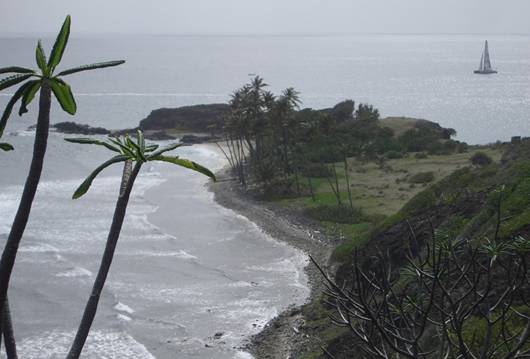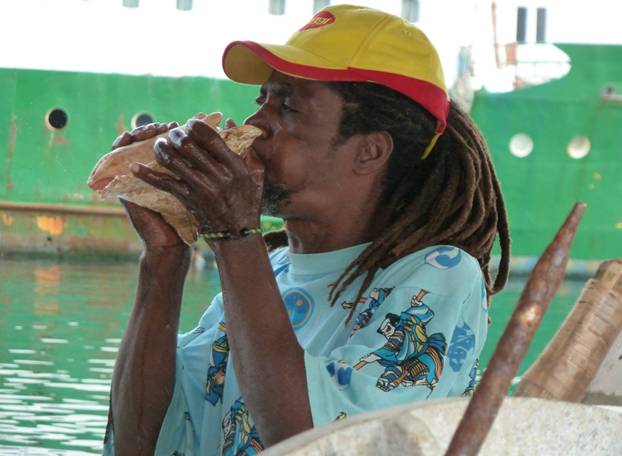Looking for Noli

|
13:50.57N
61:03.80W Our interlude in the
Well done,
Peter! It was wonderful to catch up with family and friends
and we were proud to attend son Peter’s MA graduation at * * * * * Back on board, we found it really hard to leave Le Phare
Bleu. The ship was overwhelmed with
tentacles of mangrove wrapping themselves around the ship and tying down our
arms and legs too – in short, a very bad case of port rot indeed. But leave we eventually did, and
dragging ourselves away, we sailed around the coast to St Georges. Fortuitously delayed here for 24 hrs by
poor visibility from heavy rain, we were delighted by the arrival of the
catamaran The next day, sailing north in the lee of the island,
we were pleased to cross paths with Paul on Stardust, an Oyster 56, on passage from
So onwards we sailed, pushing hard against the headwinds and west-going current towards Isle de Ronde. Our route took us close to Kick ‘em Jenny, an active underwater volcano with a 1.5 km exclusion zone around it.
The volcano last erupted in both 1988 and 1989, and it is thought the next eruption will form a new island. We anchored for lunch only 2 miles away at the uninhabited Isle de Ronde, and were much relieved that the volcano slumbered on. Apart from a pair of pelicans roosting in an old fishing boat nearby, we were the only occupants of the bay, and we enjoyed a good variety of corals and colourful tropical fish whilst snorkelling off the reefs at the head of the island, no doubt due to their remote location. Our next stop was at Sandy Island, a tiny coral island with
perfect white sand, though now with less vegetation since the hurricane
Lenny. We anchored here for the
night, and after a morning swim we made a long dinghy journey to Carriacou for provisions and customs
clearance. This island is
friendly, charming and relaxed.
With far less development than its neighbour, it looks pretty much like
the A short sail northwards again, and we anchor behind a reef
at Petit St Vincent, a pretty island
that is now an exclusive resort where the guests stay in remote stone cottages,
each equipped with a flagpole to summon room service! The hotel was built by two ex-pilots
from the US Air Force who sold up and sailed to the
Petit
The sail northwards from Petit St Vincent took us through a narrow pass in the reef between two tiny sand cays, Mopion (‘crab louse’) and Pinese (‘bed bug’). No doubt these islands were more than a minor irritation to those unfortunate sailors who were wrecked on this shoal in the days before accurate satellite navigation.
Mopion. Not much to do
here… The attractive anchorage at The following day, we sailed around the windward side of Union Island and past its short airstrip perched on an outcrop of rock. With hills to skirt on the landing approach, Stella and I mused over how difficult it must be for planes to land there. It was then that we noticed the remains of a small passenger plane at the side of the runway!
Happy
landings, Onwards, up the lee of Mayreau, and then we sailed past the
huge sailing cruise-liner Club Med 2
and into the
Club Med 2 –
a different kind of sailing
experience! Anchored off Boradel island, the variety of marine
life was amazing and swimming with green turtles in their natural habitat was
just wonderful. The following
morning, Walter, a local ‘boat boy’ (grandfather?) bought over some bread and a
banana loaf from the mainland, freshly cooked by his wife. With 3000 miles of Our next stop is a tiny deserted island called Petit
Petit
Where is
Noli? Bequia still has an easy-going and yacht friendly atmosphere. Admiralty bay, a protected natural harbour, remains unspoilt and is a hive of activity. We’re on a quest to find Noli Simmons, a friend from long ago, and we tie alongside a fishing boat to ask where he might be found. The fishing boat has just arrived after 4 days at sea, and our conversation is interrupted by the crew blowing a conch shell ‘horn’ to announce their arrival! We buy some Dorado from their huge catch, which they fillet for us on the shore and rinse in the sea.
Com’ buy me
fish
man! Tracked down at his favourite drinking haunt, Frangipani’s, Noli is great company. The
last time we drank at this bar, I was a moustachioed hippy playing my guitar
under the frangipani trees. But
Noli still remembers me. In those
days he was building a 70 foot wooden boat right next to the restaurant, using
traditional materials and techniques.
The frames were of solid local cedar, each tree chosen for a specific
part of the boat, and it was planked with silver Bali imported from
Noli – 32
years
on As well as building and sailing traditional sailing yachts, Noli is a trained architect and built his own house too. He still lives on Bequia, building another house whilst researching local history. He remains a great fan of Isambard Kingdom Brunel.
Another
lounge lizard at the Frangipani bar – this one is
cannibalistic! And Dylan’s boat? Sadly, it had an unhappy ending. Not long after completion it was lost on a reef - a complete write-off. It’s only 14 miles to the next island,
Part of the
film set for the film ‘Pirates of the Caribbean’ in The sail to
The Pitons,
St Lucia. We moored at
the base of Petit Piton, the one to the left of the
picture.
* * * * *
Just give us
the banana and sod
off.. |












